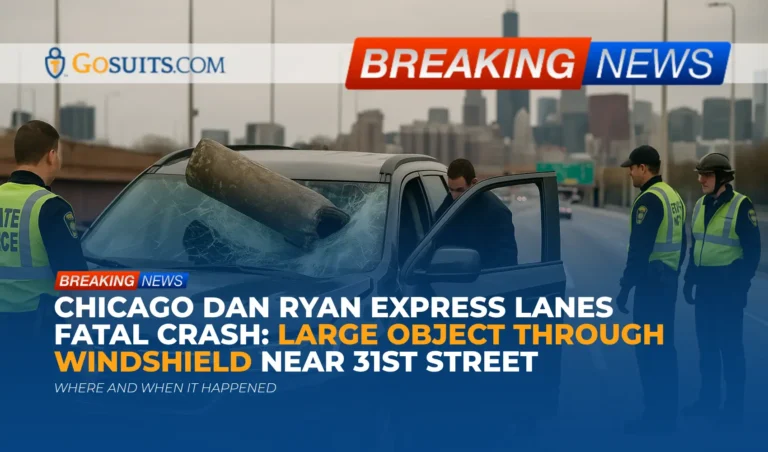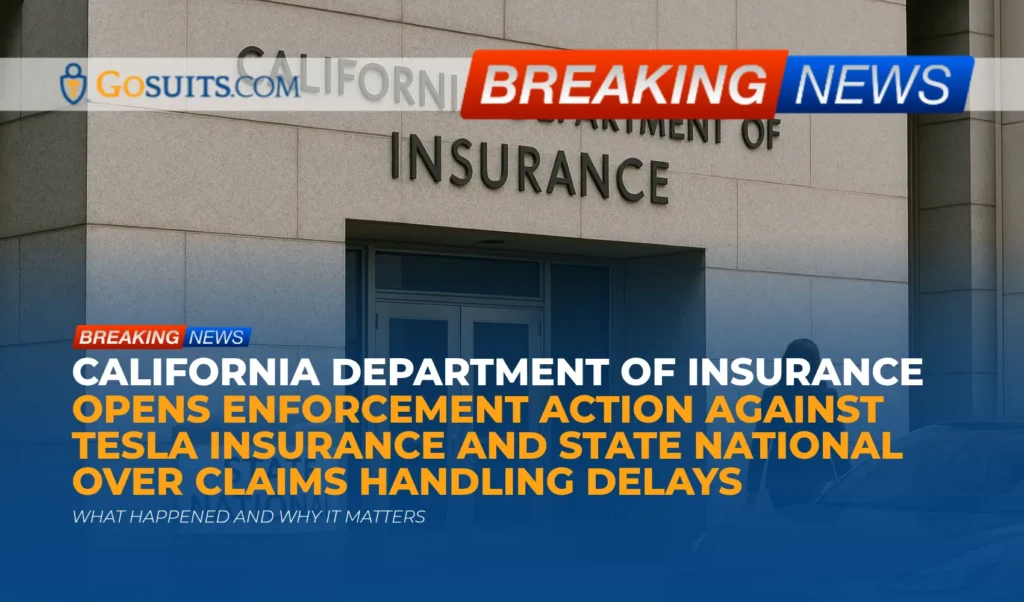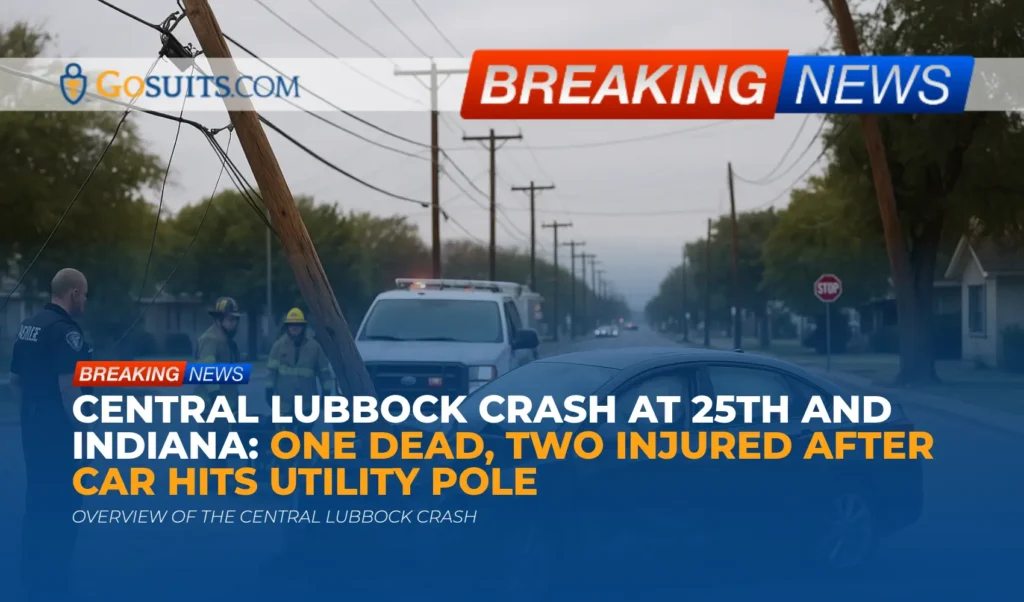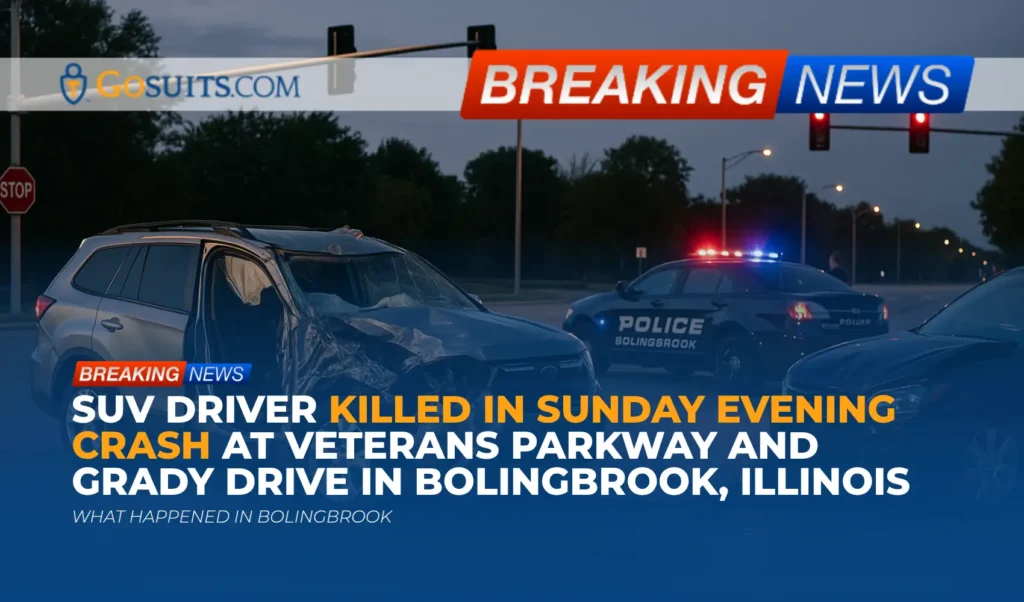- What we know so far about the Dan Ryan express lanes incident
- Where and when it happened
- Agencies involved and how to request key records
- Understanding roadway debris and “large object” windshield penetrations
- Potential civil liability pathways in similar incidents
- Insurance coverage issues after an object-through-windshield crash
- Evidence to preserve and how families can help document the case
- Why the autopsy and medical examiner records matter
- Public safety context and applicable rules
- Illinois wrongful death and survival claims: general overview
- Support resources and practical steps outside of the legal process
- Commentary from Gosuits Chicago, Illinois Personal Injury Attorney
- Time-sensitive action checklist
What we know so far about the Dan Ryan express lanes incident
A tragic crash occurred on the outbound Dan Ryan express lanes in Chicago early Monday morning, just before 5 a.m., near the approach to 31st Street. According to information reported at the scene and statements attributed to Illinois State Police, a driver in an SUV appears to have struck the wall after a “large object” went through the front windshield near the driver’s seat and struck the driver. The driver was transported to a nearby hospital and later passed away. Authorities diverted outbound traffic into the local lanes while investigators worked in the express lanes, and inbound traffic experienced heavy delays due to gapers’ congestion. As of the latest report, no additional identifying information about the driver had been released publicly.
Details about the origin of the “large object,” whether it came from another vehicle, the roadway, overhead infrastructure, or a construction or maintenance context, have not been made public. That determination typically requires a thorough investigation involving scene documentation, vehicle inspection, and analysis of any available traffic camera or dash camera footage.
Where and when it happened
Location: Outbound Dan Ryan express lanes near 31st Street, Chicago, Cook County, Illinois. The Dan Ryan corridor is part of Interstates 90/94, which are patrolled by the Illinois State Police and maintained by the Illinois Department of Transportation (IDOT).
Time: Shortly before 5 a.m. on a Monday morning, with the morning commute already developing. This timing matters for two reasons: first, early morning darkness can affect visibility of debris; second, there may be fewer witnesses on the roadway, making preservation of physical evidence and locating any available video especially important.
Agencies involved and how to request key records
When a fatal crash occurs on a state-controlled interstate in Chicago, several agencies typically play roles. Families seeking answers often need to gather records from more than one office. The following public offices and portals can help.
Illinois State Police: crash reports and investigations
The Illinois State Police (ISP) leads investigations on interstates within the city. Families or next of kin can request the official crash report when it becomes available through the ISP Crash Reports portal. In complex or fatal cases, ISP may involve crash reconstruction specialists, and certain materials may be part of ongoing investigations for a time.
Note: FOIA responses may exclude materials while an investigation is active, but requesting early can help preserve records and clarify availability windows.
Cook County Medical Examiner: cause and manner of death, autopsy reports
In Chicago, the Cook County Medical Examiner determines cause and manner of death in sudden, unexpected, or traumatic fatalities. Autopsy and toxicology reports are key medical documents that help families and insurers understand what occurred. The Medical Examiner’s office offers an online process for requesting autopsy reports, which generally become available after testing is complete.
Illinois Department of Transportation: roadway conditions, maintenance, and traffic management records
IDOT maintains the Dan Ryan roadway and may have records about roadway inspections, maintenance activities, debris removal calls, or construction permits in the area. Families or their representatives sometimes request relevant maintenance logs or traffic management notes through IDOT’s FOIA portal. Video from traffic management cameras can be limited and often is not archived for long; timely requests are important.
City of Chicago OEMC: 911 records and potential camera footage
While the interstate is a state jurisdiction, 911 calls within city limits are typically handled by the City of Chicago’s Office of Emergency Management and Communications (OEMC). In some situations, audio or dispatch records and potential city camera footage may exist. Retention periods can be short, making prompt requests a priority.
Vital records: death certificates
Certified death certificates are generally requested through the Illinois Department of Public Health or the Cook County Clerk. These documents are often necessary for insurance claims and estate matters.
Understanding roadway debris and “large object” windshield penetrations
A “large object” entering a windshield is among the most dangerous roadway hazards because it can cause catastrophic trauma even at moderate speeds. Objects may originate from unsecured loads on vehicles, parts falling off other vehicles, debris left on the roadway after prior incidents, or materials associated with construction or maintenance activity. In rare cases, materials from overhead structures can dislodge. Each scenario carries different implications for responsibility and evidence.
Key safety considerations for windshield penetration events include:
- Velocity multiplies risk. Even a mid-weight object can become lethal when propelled into oncoming traffic, particularly at interstate speeds.
- Tracing the source is urgent. The ability to identify where the object came from is often time-sensitive. Physical debris can be swept quickly, and video retention windows can be short.
- Scene preservation matters. Photographs of the scene, any object fragments, scrape marks, and vehicle damage patterns can help reconstruction efforts.
- Dash cameras can be decisive. Many vehicles, including rideshare or commercial fleets, use dash cameras or backward-facing cameras that may capture the cause.

Potential civil liability pathways in similar incidents
While each case depends on evidence, several possible liability theories can arise when an object penetrates a windshield on a highway:
- Unsecured load from another vehicle. Illinois law prohibits driving a vehicle unless it is constructed or loaded to prevent its load from dropping, leaking, or otherwise escaping. See 625 ILCS 5/15-109. If an object fell from a vehicle because it was improperly secured, that driver or company may face civil responsibility.
- Vehicle part failure and detachment. If a component detached from a vehicle due to poor maintenance or a defect, potential responsibility could include the vehicle owner or, in some cases, a manufacturer or repair facility, depending on what the evidence shows.
- Roadway maintenance or construction activity. If debris was left in travel lanes from construction, utility, or maintenance work, the entity responsible for site safety could be implicated. Determining this typically requires records from IDOT, contractors, and permit files.
- Prior incident debris not cleared. If a prior crash or tire blowout left debris that should have been removed and there is evidence of unreasonable delay in clearing it, questions about maintenance response can arise.
- Unknown or “phantom” vehicle. Sometimes, the object source cannot be identified immediately. In those cases, uninsured motorist coverage may still come into play, as discussed below.
It is important to understand that responsibility can involve multiple parties and insurance policies. Early, careful investigation helps avoid the loss of critical proof.
Insurance coverage issues after an object-through-windshield crash
Insurance can be complicated in incidents where a foreign object strikes a vehicle. The following coverage types may be relevant in Illinois:
- Uninsured Motorist (UM) coverage for bodily injury. Illinois requires auto policies to include uninsured motorist coverage for bodily injury. See 215 ILCS 5/143a. If the object came from an unidentified vehicle (“phantom vehicle”), a UM claim may be possible. Statements given to insurers are important and can affect coverage.
- Underinsured Motorist (UIM) coverage. If a responsible driver is identified but lacks sufficient liability limits, UIM coverage may help address uncompensated harms within policy limits.
- Liability coverage of a known at-fault party. If investigators identify a specific vehicle, company, or contractor responsible for the object entering the roadway, that party’s liability insurance may apply.
- Medical payments (MedPay). Some Illinois policies include optional MedPay coverage that can contribute to medical or funeral costs without regard to fault, subject to policy limits and terms.
- Property damage coverage. Depending on the policy, collision coverage may address vehicle damage. If a responsible third party is later identified, the insurer may seek reimbursement from that party.
Because policy language varies and recorded statements can be used later in claim decisions, it is prudent to consult with a knowledgeable attorney before communicating extensively with any insurance adjuster, including your own carrier. A consultation can clarify what information is necessary, how to preserve coverage rights, and how to avoid inadvertently harming a potential claim. What you say early on can be cited later in coverage determinations.
Evidence to preserve and how families can help document the case
When an object penetrates a windshield, key evidence can disappear quickly. Timely steps can make a significant difference in understanding what happened:
- Preserve the vehicle intact. Request that no repairs or alterations be made until the vehicle can be inspected and photographed by your chosen investigator. The point of windshield penetration, glass fracture patterns, interior strike marks, and embedded debris can all be crucial.
- Secure any object fragments. If any pieces of the offending object were recovered, store them in a clean, labeled container and keep a chain-of-custody log of who handles them.
- Obtain official reports. Request the Illinois State Police crash report when available through ISP Crash Reports. If reconstruction was performed, note the case number for follow-up.
- Request audio and dispatch records. Consider a timely FOIA to OEMC for relevant 911 calls and radio traffic, which may mention debris or a vehicle losing cargo.
- Ask about traffic cameras. Submit a prompt FOIA to IDOT to inquire whether any traffic management cameras in the area captured the event or a vehicle shedding cargo. Retention can be short.
- Canvass for private video. Commercial vehicles, rideshare drivers, and nearby businesses sometimes capture incidents on dash or security cameras. Early outreach improves the odds of locating footage before it is overwritten.
- Document road conditions. Photos of the scene location, lane markings, any construction signage, and the condition of the express lanes on the day of the incident can support analysis.
- Coordinate with the Medical Examiner. Ensure next of kin communications are current with the Cook County Medical Examiner so you can obtain records when they are ready.
Why the autopsy and medical examiner records matter
Autopsy and toxicology reports from the Medical Examiner help establish the mechanism of injury, timing, and medical cause of death. In object-through-windshield cases, the reports may describe specific wound tracks or impacts that correlate with vehicle damage patterns and debris analysis. This medical-physical linkage can be important when reconstructing events and when insurers evaluate causation.
Families can request these documents through the county’s process once testing is complete. See Cook County autopsy report requests. If additional medical records exist from the hospital where the driver was treated, those records may also be relevant and can be requested by the legal next of kin or a personal representative with proper authorizations.
Public safety context and applicable rules
Illinois law addresses loads and debris on roadways to reduce the risk of incidents like this:
- Spilling loads prohibited. Illinois prohibits operating a vehicle unless it is loaded or constructed to prevent cargo from dropping, shifting, or escaping. See 625 ILCS 5/15-109.
- Commercial cargo securement. Federal cargo securement standards apply to commercial motor vehicles transporting loads that could shift or fall. See the Federal Motor Carrier Safety Administration cargo securement rules at FMCSA Cargo Securement.
On a broader level, national safety agencies provide data and research on traffic injuries and fatalities. For example, the National Highway Traffic Safety Administration compiles annual fatality analysis data that informs roadway safety strategies nationwide. See NHTSA FARS. While FARS is not limited to debris incidents, it underscores the serious consequences of high-speed impacts and the importance of preventative measures, including proper load securement and timely debris removal.
Illinois wrongful death and survival claims: general overview
When a life is lost in a roadway incident, Illinois law allows certain civil claims to be brought to address harms to both the family and the decedent’s estate. The two primary frameworks are the Wrongful Death Act and the Survival Act. The following is general information, not specific advice.
- Wrongful Death Act. A claim may be brought by the personal representative of the decedent for the benefit of the surviving spouse and next of kin to address losses such as grief, loss of society, and financial support. See 740 ILCS 180. In many cases, the general filing window is two years from the date of death, though circumstances can vary. See 740 ILCS 180/2.
- Survival Act. Certain claims the decedent could have brought if they had survived may continue on behalf of the estate, such as conscious pain and suffering before death. See 755 ILCS 5/27-6.
- Claims against public entities. If a claim involves a state agency, there may be special procedures, including the Illinois Court of Claims process. See the Illinois Court of Claims. Deadlines and notice rules can differ from ordinary court cases.
- Evidence and timing. Because video retention is short and crash scenes change quickly, prompt preservation efforts are often as important as the legal filing deadlines.
Families often have questions about who may serve as the personal representative and how insurance interacts with these claims. Those answers depend on the specific facts, the decedent’s estate status, and available policies. A free consultation can help clarify options without requiring any commitment.
Support resources and practical steps outside of the legal process
Grief and urgent logistics often collide after an unexpected loss. In addition to obtaining official records, the following resources may help:
- Death certificates. Certified copies are used for insurance and administrative matters. Request through the Illinois Department of Public Health or the county clerk.
- Medical Examiner updates. Keep contact information current with the Cook County Medical Examiner for timing on autopsy and toxicology.
- Emotional support. The national 988 Lifeline provides free, confidential support at any time. See SAMHSA 988.
- Employer and benefits coordination. Human resources departments can assist with life insurance claims and leave policies. Having official documents ready can speed the process.

Commentary from Gosuits Chicago, Illinois Personal Injury Attorney
We extend our deepest condolences to the family and loved ones affected by this heartbreaking incident on the Dan Ryan. Losing someone so suddenly and unexpectedly is devastating, and our thoughts are with those who are grieving. The information here is shared for education and general guidance, with respect for the family’s privacy and the ongoing investigation.
Based on the early description that a “large object” entered the windshield and struck the driver, the most pressing questions are what that object was, where it came from, and whether it should have been on the roadway at all. Unsecured cargo, dislodged vehicle parts, and debris from roadside activity are well-known hazards. The law in Illinois and at the federal level recognizes the danger by requiring loads to be secured and prohibiting materials from escaping into traffic. Investigations that document debris patterns, collect fragments, and track any available video are vital to determining responsibility.
Insurance companies and large entities often move quickly after incidents, and they are experienced in guiding conversations in ways that limit exposure. It is common for adjusters to request recorded statements very early. People who are still in shock may not realize that what they say can be used later to deny or restrict coverage, particularly in cases where an at-fault vehicle is not yet identified and uninsured motorist coverage may be needed. Corporations and carriers also control many of the records and experts necessary to evaluate what happened, which can leave families at an informational disadvantage during an already overwhelming time.
A free consultation can level the information gap and help outline next steps without any obligation. Speaking with a seasoned, skilled attorney before giving statements to any insurer can help protect available coverage and ensure that crucial evidence is preserved while it still exists.
Time-sensitive action checklist
The following steps can help protect information and options in the days and weeks after a serious roadway incident involving debris or a large object:
- Request official records promptly. Note the case number and request the Illinois State Police crash report when available through ISP Crash Reports. Submit FOIA requests early to ISP, IDOT, and OEMC to preserve any dispatch logs, roadway maintenance records, or potential camera footage.
- Coordinate with the Medical Examiner. Stay in contact with the Cook County Medical Examiner about report availability, and plan to request the autopsy and toxicology findings when ready at this link.
- Preserve the vehicle and debris. Ensure the vehicle is stored securely and not altered. Keep any recovered fragments in a labeled container and document who handles them.
- Secure private video quickly. Dash cameras and business security systems often overwrite footage in days. Make a list of potential sources near the incident area and send preservation requests in writing.
- Gather insurance policies but pause before detailed statements. Collect all applicable auto and umbrella policies to review UM and UIM provisions. Speak with an attorney first before giving recorded statements to any insurer, as early remarks can shape coverage decisions.
- Track expenses and impacts. Maintain a folder for funeral expenses, travel costs, lost income documentation, and any counseling or support receipts. Organized records can reduce stress later.
- Understand general timelines. Illinois law sets time limits for bringing wrongful death and related claims. See 740 ILCS 180 and 755 ILCS 5/27-6. Acting sooner helps ensure evidence is not lost.
- Consider potential public-entity procedures. If indications point toward a state or public contractor’s responsibility, be aware that claims processes and deadlines can differ. See the Illinois Court of Claims for general information.
Taking these steps early can preserve options, clarify what happened, and reduce the risk that key evidence is lost before it can be evaluated. Timing matters because camera footage, debris, and witness memories can fade quickly, especially along busy interstates like the Dan Ryan where maintenance crews must clear hazards promptly for public safety.






